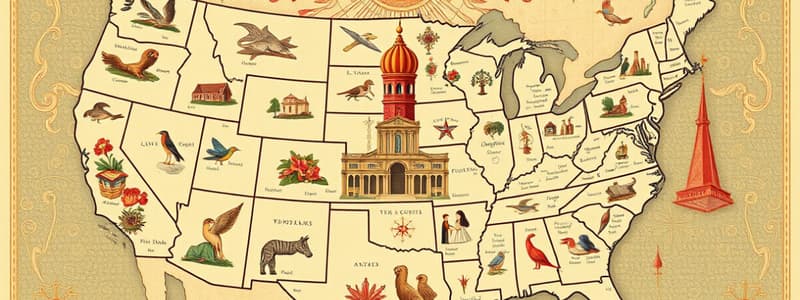Podcast
Questions and Answers
What is the process of becoming a state that is recognized by other states called?
What is the process of becoming a state that is recognized by other states called?
- Federalization
- Sovereignty
- Consolidation
- Statehood (correct)
Which of the following states is the largest in the United States?
Which of the following states is the largest in the United States?
- Montana
- California
- Texas
- Alaska (correct)
How did railroads contribute to U.S. western expansion?
How did railroads contribute to U.S. western expansion?
- They increased reliance on telegraph systems.
- They allowed communication over long distances.
- They isolated communities from each other.
- They enabled faster movement of goods and people. (correct)
Which factor is NOT mentioned as influencing the geographic patterns of the U.S.?
Which factor is NOT mentioned as influencing the geographic patterns of the U.S.?
What factor contributed significantly to the westward expansion of the United States aside from natural resources?
What factor contributed significantly to the westward expansion of the United States aside from natural resources?
Which of the following locations is identified as a unique state due to its geographical characteristics?
Which of the following locations is identified as a unique state due to its geographical characteristics?
What landscape feature is associated with the Canadian Shield?
What landscape feature is associated with the Canadian Shield?
Which region of Canada is known for its potential economic expansion in the 21st century?
Which region of Canada is known for its potential economic expansion in the 21st century?
How did immigration impact the growth of the United States during its early years?
How did immigration impact the growth of the United States during its early years?
What impact do the Canadian Cordillera mountains have on the country's climate?
What impact do the Canadian Cordillera mountains have on the country's climate?
Study Notes
Understanding States
- A state is a governing entity that controls a specific territory and its population.
- Statehood refers to the process of becoming a recognized state, which can include joining the United States.
- Not all U.S. regions are states; examples include unincorporated territories like Puerto Rico and the District of Columbia, which houses the federal government.
Identifying U.S. States
- Size: Alaska is the largest state; Rhode Island is the smallest.
- Shape: Michigan resembles an oven mitt; Louisiana looks like a Christmas stocking.
- Panhandle: Oklahoma and Florida have narrow extensions from their main landmass.
- Unique location: Alaska is the northernmost state, while Hawaii is the only island state.
- Regions: Understanding commonalities within regions aids in identifying states.
Early U.S. Settlement and Expansion
- Initial settlement featured challenging living conditions, yet English colonies became predominant.
- The original 13 colonies eventually formed the United States.
- Population growth and movement westward were influenced by improved living conditions and abundant natural resources.
Factors Influencing Westward Expansion
- Natural resources such as coal, oil, and gold accelerated expansion.
- Immigration played a critical role by increasing labor productivity and economic growth.
- Population pressures in established towns encouraged individuals to seek land opportunities in the West.
- Government support and incentives facilitated westward movement.
Transportation and Communication Advances
- Telecommunication via telegraphs and rapid transit via railroads transformed distances and sped up goods and people movement.
- Railroads significantly changed western expansion rates; later innovations like telephones and highways further enhanced mobility and communication links.
Geographic Patterns and Canadian Overview
- The lesson acknowledges missing details on the Canadian prairies, Rocky Mountains, and Acadian history but emphasizes significant human and physical traits of Canada.
- The English-French divide and aboriginal rights have shaped Canadian history and continue to be relevant today.
- The Alberta oil patch is crucial to the Canadian economy; the Arctic region offers potential for future economic growth.
Key Canadian Landforms
- Canada ranks as the second-largest country by area with vast landscapes.
- The Canadian Cordillera connects various mountain ranges, contributing to weather patterns that affect the interior plains.
- The Canadian Shield features extensive bedrock, forests, and lakes, while the Arctic Archipelago remains largely frozen year-round.
- Southern Ontario and Quebec's geography is defined by the Great Lakes and the St. Lawrence River, highlighting the country's natural resources and waterways.
Studying That Suits You
Use AI to generate personalized quizzes and flashcards to suit your learning preferences.
Description
This quiz explores the concept of a state and its relationship to territory and sovereignty. It covers the definition of statehood and the various types of governmental units, including semi-autonomous regions and territories within the United States. Test your understanding of these important political concepts.




